Organic food, natural food, comfort food, bowl food, soul food, fast food, local, heritage. These are all words that evoke an emotional response when we think about what we want to eat and the reasons we buy into specific brands and products.
As the consumer exodus from the High Street continues, food and drink retailers without a brick-and-mortar presence are busy working out how to use product descriptions to tap into why online shoppers buy the products they do. On the flip side, our favourite dining spots are looking for new ways to increase footfall with effective content marketing.
The food copywriting you use to do this is as crucial as those fantastic photographs you post on your website, Instagram and the social media hinterland.
Find out about our food copywriting service»
As an online retailer, you probably spend a long time either creating your own products to make them as delicious as they can be or assembling the kind of product ranges that culinary dreams are made of. And that’s great, but people can’t taste your products through the screen, and unless they’ve sampled them before, they really don’t know what they taste like or why they should buy them. That’s where excellent copywriting for food skills comes in handy…
For that reason, it really is critical that you make sure the product description is every bit as tasty as the products themselves. Let’s take a look at the main components of successful food content writing.
Where does your food copywriting count?
Which one sounds more appealing? ‘Steak Pie’ or ‘Yorkshire Rich and Tasty Steak Pie’. The words you write have significant sway with potential customers. If something sounds a little more luxurious, high-quality or indulgent, when it comes to choosing a product over others on a shelf, the latter will probably win.
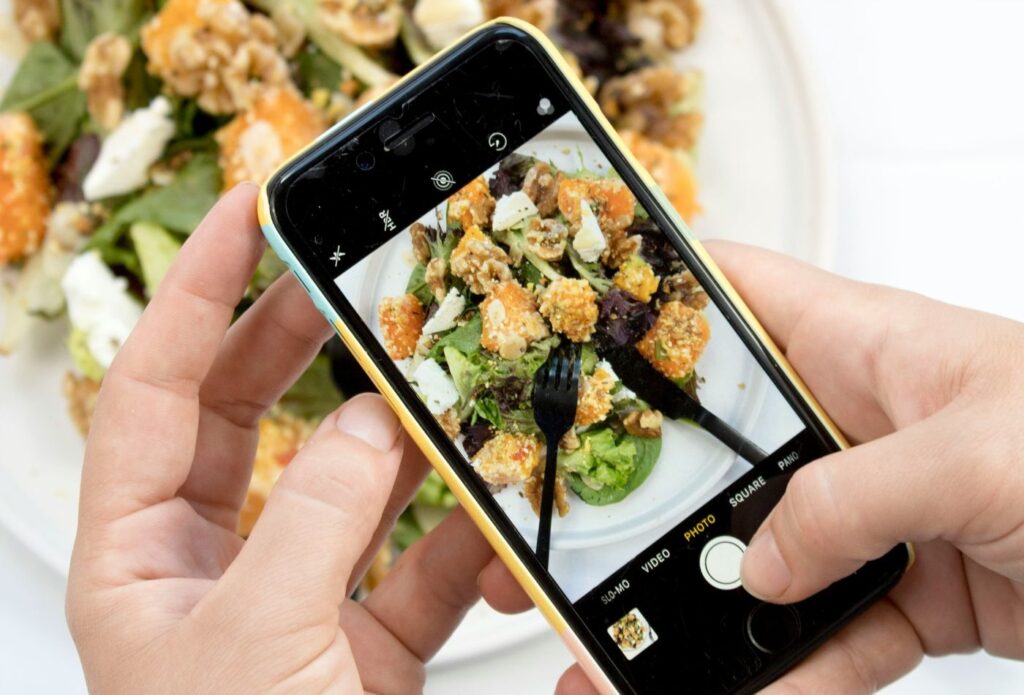
When writing about food, your copywriting counts at multiple customer touch points. These include:
- Social media posts
- Restaurant or takeaway menus
- Coupons and vouchers
- Printed advertising
- Website/landing pages
- Email marketing
- Online Ads
- Product descriptions
The content you write for each of the above will differ. And that’s because how we connect with our reader in each interaction alters slightly, too. We’ll get into the specifics of how to write good copy for each of these means later in the blog, But first, let’s look at what generally makes effective food copywriting.
Who’s coming to dinner?
The first thing you need to consider is who you are writing for, what they are interested in, what they value, and how your product benefits them.
If you were chatting together at the dinner table, what would you say about your product? What questions would they ask you? How would the conversation go? When writing about food, your audience must be at the forefront of your mind.
Every brand should establish its audience first and foremost. And if you haven’t, read this blog before you do anything else.
Knowing how to approach your audience is important because different people expect different things. McDonald’s will communicate with their customers in a very different tone to Nobu’s. And likewise, Aldi is likely to approach their copywriting in ways that are polar opposites to M&S or Waitrose.
Pinpoint who you are targeting first. This will help you establish clear rules and guidelines for successfully reaching the right people later.
Beyond the first bite
The first bite is with the eye, which is why Instagrammers devour picture-perfect food and drink images in their millions. But food is about so much more than aspirational food imagery. To effectively sell online, you need to engage your customers’ senses.
A photo won’t do it, but exceptional food content writing can (and should) give the customer a good idea of what actually eating the product would be like. Just as you invest in the best food photographers to make your products stand out, you should also invest in skilled writers who can bring the tastes of your offerings to the fore.
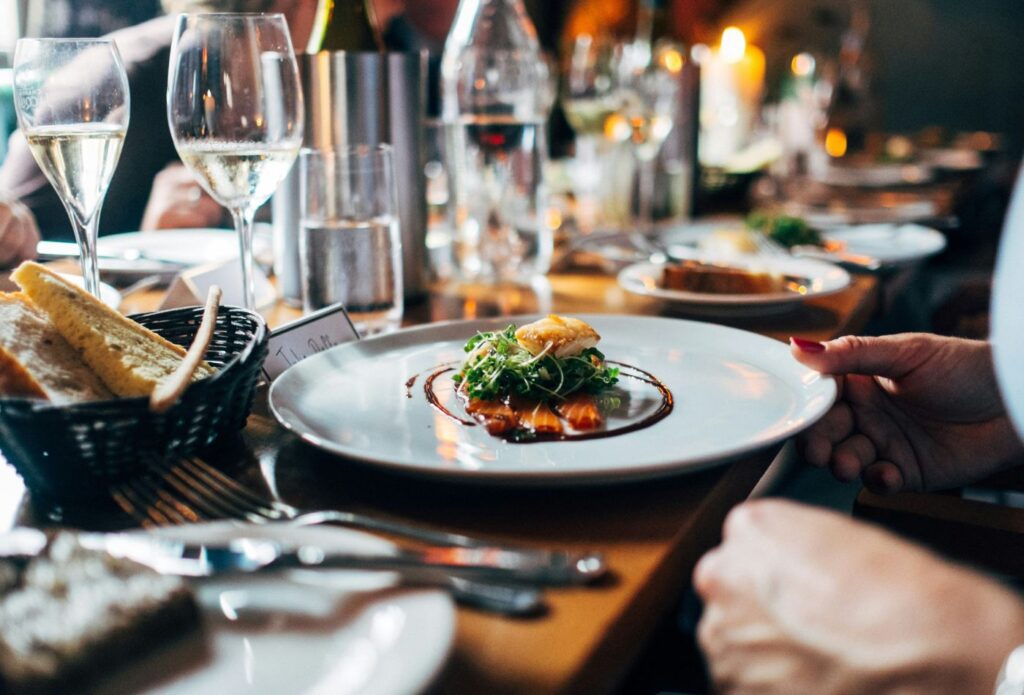
Engaging your customers’ senses
Aroma
Smell is perhaps the most powerful of all our senses, and we’ve all experienced moments when a scent has carried us down memory lane. Good food copywriting plays on the strength of this primal sense, with words like fresh, minty, aromatic and fragrant mixing well with comparative similes borrowed from other areas of language.
Taste
Taste is paramount in any culinary product description, and a professional food copywriter knows how to use it to sing siren songs to the taste buds of those reading.
As well as describing the nature of the taste with words like sweet, savoury, astringent or chocolatey, good food content writing can also provide indicators of the extent and intensity of these tastes. For someone looking to buy a curry meal kit, for example, whether the product is mild, hot, spicy, fiery or ferocious is of supreme relevance.
Texture
When you put something in your mouth, you don’t just taste it; you feel it. You sense whether it’s crunchy, gooey, chewy, supple, hard, tender or smooth. Including textures in your product descriptions enriches the mental visualisation of the food in the reader’s imagination.
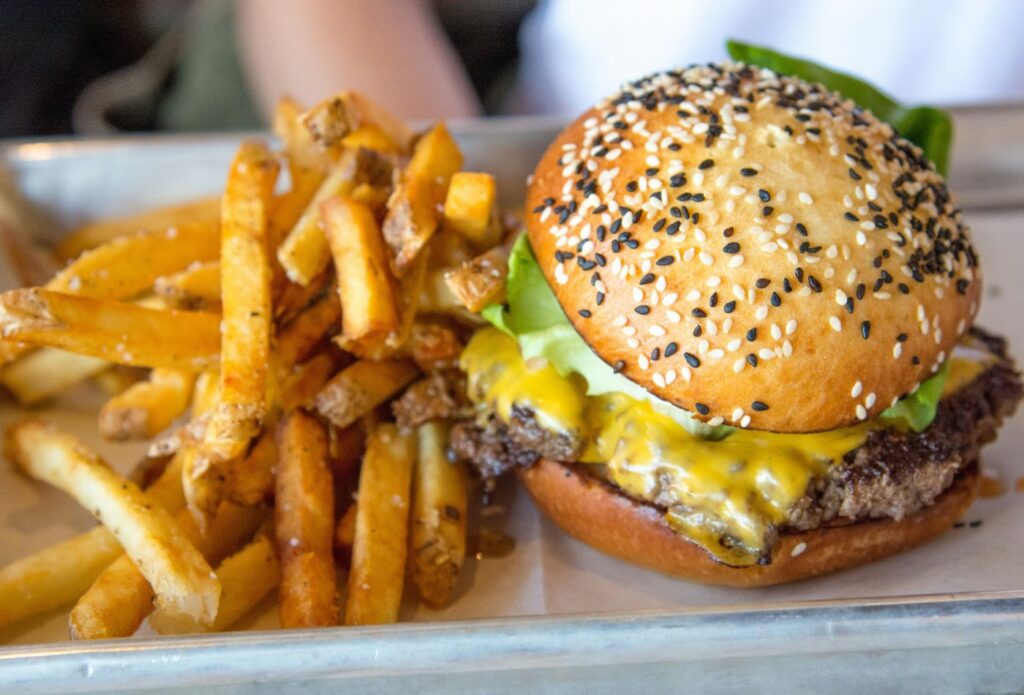
Take it easy on the food poetry, though
Nuts and bolts – Hopefully, there aren’t actual nuts and bolts in your dishes (though if there are, be sure to point it out), but you should be careful that you don’t get so carried away in waxing lyrical about the food poetry that your products create – that you forget to say what is actually in them. And, of course, what’s not.
Some people are particularly fond of certain ingredients, while others may dislike them with a passion or even suffer from digestive problems. Being crystal clear about what your food contains will entice the first group and prevent the other two from making a purchasing mistake that turns them off your entire brand.
Sharing food stories
People like eating food that has provenance and a story. So if your food is the result of a family recipe handed down through generations, or if it’s been developed over many years by top chefs, ethically sourced or from a seldom explored corner of the world, be sure to highlight these origins. Writing about food can be taken to the next level when a story is introduced.
Knowing where your ingredients come from is as equally important for customers and restaurantgoers. If your ingredients are locally sourced, hand-reared and carefully packaged just 20 minutes down the road, shout about it. Likewise, if something is rare, unique or expertly blended, shout about that too. Your price point will likely be determined by the quality of the ingredients and time spent making your tempting treats. Therefore, you need to be transparent with potential customers so they know they are getting a good bang for their buck.
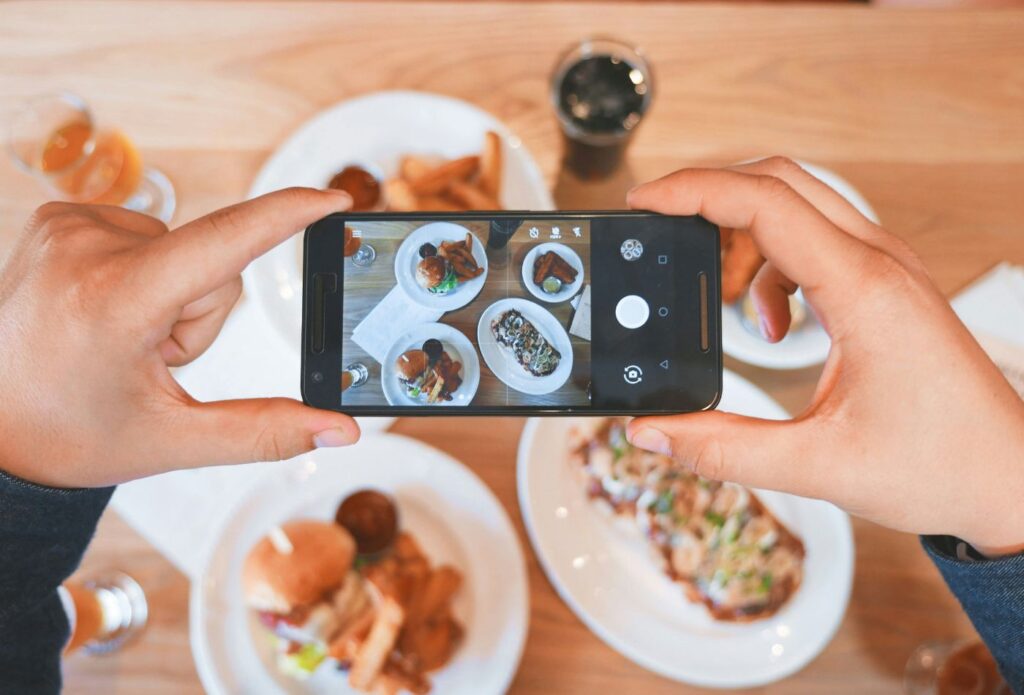
Cooking up a brand image
When writing about food, each product description should help to build a picture of your brand while also standing out on its own. If you can latch onto some broad themes within your offerings and then blend these into all of your product descriptions, you can strengthen the impact of your website as a whole, improve brand recognition and make each description work harder towards conversions.
Brands that do this well have worked on a unique and memorable tone of voice, vital in developing a recognisable brand personality. Spend time pinpointing your brand positioning and messaging; figure out what you want to be known for, why you do what you do, and the unique selling point you can bring to the table to attract new customers.
Effective food copywriting techniques
Here are our top copywriting tips and content marketing tricks for writing tasty food copy for the mediums that should be important to your brand:
Food social media post copywriting
- Mouth-watering descriptions: Craft vivid and sensory-rich descriptions of your food. Use words that evoke taste, texture, and aroma to make followers crave the dish. Feel free to be creative, explosive and experimental on your social media platforms – where appropriate, of course.
- Engaging hashtags: Incorporate popular and relevant hashtags to increase discoverability. Create branded hashtags to encourage user-generated content and engagement.
- Limited-time offers: Leverage the urgency factor by promoting limited-time specials or discounts. Use phrases like “today only” or “exclusive offer” to drive immediate action. This is a great way to convert social users to loyal customers.
- Interactive content: Encourage interaction by asking questions, running polls, or hosting contests related to your products. User engagement can boost visibility and create a sense of community, while fun interactions can boost customer retention – especially if they feel their thoughts or ideas are being listened to.
- Behind-the-scenes stories: Share behind-the-scenes glimpses of your kitchen, chefs, or the making of a signature dish. Personalise your brand and connect with the audience on a human level.

Restaurant or takeaway menu copywriting
- Descriptive language: Use enticing adjectives and vivid language to describe each dish. Highlight unique ingredients, cooking methods, or the story behind the recipe. Make sure you highlight any allergens, too.
- Strategic placement: Position high-margin or signature dishes strategically on the menu. Use visual cues such as borders, colours, or images to draw attention to these items.
- Bundle deals: Think about creating value-driven bundles or combo meals to encourage customers to try multiple items. Mention any cost savings to make it an attractive proposition.
- Highlight specials: Clearly emphasise daily or seasonal specials using eye-catching fonts or graphics. Make them stand out from the regular menu items – and clearly state why these items are special. They need to have the wow factor.
- Readability: Ensure the menu is easy to read with clear headings and concise descriptions. Use visual hierarchy to guide customers through different sections and emphasise key information.
Vouchers and Coupon copywriting
- Clear call-to-action: Clearly state the action you want the customer to take. Whether it’s “Bring to the restaurant” or “Use Code XYZ,” make it easy for them to understand. It needs to be explicitly clear to avoid confusion, too.
- Scarcity language: Instil a sense of urgency with phrases like “Limited Quantities” or “Valid Until [Date].” Encourage prompt redemption to capitalise on the coupon and watch the sales flood in.
- Exclusive deals: Make customers feel special by offering exclusive discounts for coupon users. Use words like “exclusive offer for our valued customers” to create a sense of privilege. It pays to look after the customers already on your side.
- Visible terms: Clearly communicate any terms or conditions associated with the coupon. This transparency builds trust and prevents misunderstandings.
- Personalised coupons: If possible, personalise your vouchers based on customer preferences or past orders. This adds a tailored touch and increases the likelihood of redemption.
Printed advertising copywriting for food
- Compelling headlines: Grab attention with compelling headlines highlighting a unique selling point or a tempting offer. Make it clear why your food is a must-try.
- Visual appeal: Use high-quality images of your food to make your mouth water. Images should align with the overall theme and vibe of your brand.
- Concise copy: Keep your copy concise and focused on the most critical information. Avoid clutter and make it easy for readers to absorb key details quickly.
- QR codes: Include QR codes linked to your website or online menu for easy access to more information. This bridges the gap between print and digital marketing.
- Testimonials or reviews: Incorporate positive customer testimonials or reviews to build trust. Real experiences can be powerful in convincing potential customers to try your food.
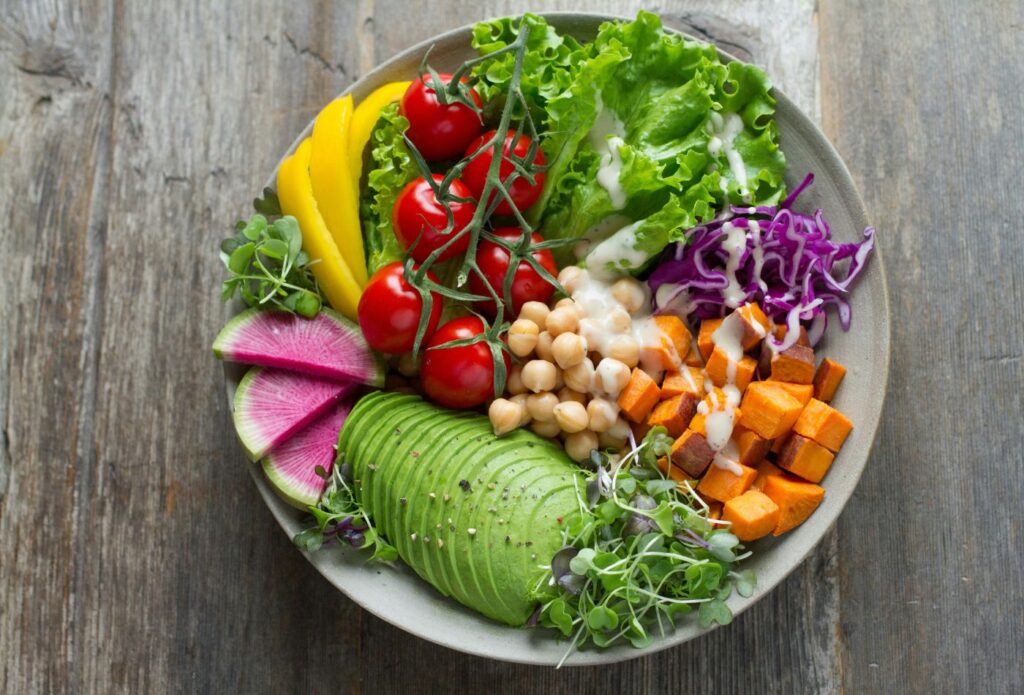
Website/landing pages
- Compelling headline and subheadings: Capture attention with a persuasive headline and use subheadings to break down information. Clearly convey what sets your food apart.
- Emotional appeal: Appeal to emotions by describing the experience of enjoying your food. Use storytelling to create a connection with visitors.
- Clear call-to-action (CTA): Have a clear and prominent CTA directing visitors to order, explore the menu, or sign up for special offers. Use action verbs for emphasis.
- Mobile optimisation: Ensure your website is optimised for mobile users. Many people – probably the vast majority – browse food options on their phones, so a responsive design is crucial for a positive user experience.
- SEO-friendly copy: Incorporate relevant keywords related to your cuisine and location for better search engine visibility. This helps potential customers find your restaurant online.
Email marketing for food
- Personalised subject lines: Use personalised subject lines to increase open rates. Include the recipient’s name or reference their past orders to grab attention.
- Visual appeal: Incorporate mouth-watering images of your dishes within the email. Visuals play a crucial role in enticing customers to place an order.
- Limited-time Offers: Create a sense of urgency by promoting limited-time offers or exclusive discounts. Clearly state when the offer expires to drive prompt action.
- Segmented campaigns: Segment your email list based on customer preferences or order history. Tailor your messages to specific groups to increase relevance and engagement.
- Engaging copy: Write engaging, conversational copy that speaks directly to the reader. Highlight the benefits of ordering from your restaurant or food brand and make it easy for them to take action.
Online ads for food
- Eye-catching visuals: Use high-quality, appetising visuals to grab attention. A tempting image can make users stop scrolling and focus on your ad.
- Concise messaging: Keep ad copy concise and focused on the key message. Highlight the most compelling aspects of your food or any ongoing promotions.
- Clickable elements: Ensure your ad includes clickable elements like buttons or links that direct users to your online menu or ordering page.
- Local targeting: If applicable, use local targeting options to reach users in specific geographic areas. This is especially effective for attracting nearby customers.
- A/B testing: Conduct A/B testing with different ad copies, visuals, or calls to action. Analyse which elements perform best and optimise your future ads based on the results.
Food product descriptions
- Sensory language: As we mentioned earlier in this blog, you need to appeal to the senses with descriptive language that vividly describes the taste, aroma, and texture of the food. Help customers imagine the experience – you need to make their mouths water.
- Storytelling: Share the story behind each dish, whether it’s a family recipe, a chef’s inspiration, or the origin of special ingredients. This adds depth and authenticity.
- Pairing suggestions: Recommend complementary items or suggest beverage pairings to enhance the overall dining experience. This can upsell and encourage customers to try more. It also helps them picture how to make the most of your product.
- Portion size clarification: Clearly communicate portion sizes to manage customer expectations. Use terms like “generous serving” or “perfect for sharing” to convey value. There’s nothing worse than buying something you hoped would serve more.
- Highlight health benefits: If applicable, emphasise any health-conscious elements of your dishes. This could include fresh, organic ingredients, gluten-free options, or low-calorie choices. The importance of this will change on your customer base, so make sure to apply this with that in mind.
A last morsel to consider
In a post-Covid world, many of the online food shopping habits have stuck, with 90% of grocery shoppers opting to grocery shop online regularly. While in-store experiences still appeal to many, keeping your customers’ online store experience and social feeds fresh with valuable content is crucial to securing basket share.

Mouth-watering food description examples
The food and drink scene can be a hard one to crack, but you can make all the difference by using the right words to entice feasting eyes towards your products. We wrote a blog with 20 best examples of effective food copywriting from brands at the top of their game. We recommend reading this blog if you want some inspiration before diving into your copywriting.
Great food content writing is about more than tasty product descriptions. Are you prepared?
Tastier words lead to more satisfied customers. That’s the bottom line of effective food copywriting. And today, spending money at High Street dining hot spots or placing an order online is all about the experience. Customers want to shop with brands they know and can trust. They want a high-quality meal or food ingredients. At Big Star, we help you communicate what makes your business different. Our small but talented team of food copywriters has a knack for digging deep and identifying what makes your products more tempting than the rest. If you need a hand creating excellent copy, get in touch. We’d love to help.

Very interesting worthy of reading
Glad you enjoyed it!
Great and informative
Glad you enjoyed it 🙂
So educative
Thank you for sharing, I learnt a lot
Very enlightening